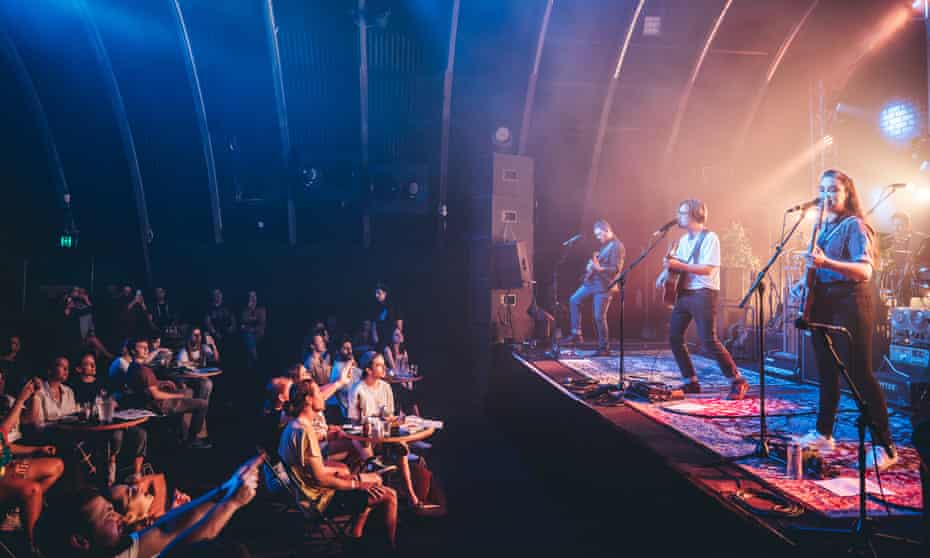February 10, 2022
After almost 2 years of little to no live music in Ireland, no plays, concerts or anything of the sort, it’s almost foreign to us to see the pubs in Dublin swarming with music enthusiasts and hearing the classic Irish folk tunes every time you’re walking down any major Dublin street. But how did the two years of silence affect the live music industry, and will it ever be the same? Are there more or less people returning to watch gigs since they’ve made their grand comeback, or have people lost their spark for live music? This blog is going to outline how the global pandemic has affected the live music industry and Irish musicians, the gradual and possibly successful return of live performances and what the future of live music may be, will it even be in person?

One such voice for the music industry was renowned Irish musician, Steve Wall, who had pointed out in August 2021 that live music had been capped at 200 people whilst 40,000 odd people would be attending the All-Ireland final. To quote Steve; “The whole music industry should be out on the street marching about this”, and this may be rightly so. The live music and concert industry lost approximately 30 billion USD in 2020 alone due to restrictions from the pandemic. Musicians were frustrated with these double standards, with little to no recognition from the government, can you blame them? According to IMRO (Irish Musical Rights Organisation) the music industry supports over 11,500 jobs nationwide, whilst contributing over half a billion euro to our economy. Just like those in the performing arts industry and publicans, musicians felt almost invisible through the eye of the pandemic.
Ever since live gigs were announced to be returning officially on January 22nd, it was interesting to see how people would react. Surely musicians who made a living this way would be relieved, and live gig enthusiasts would be over the moon too. Many thought there would be a hesitancy amongst some to return to viewing gigs, which there initially was, as most gigs being ran throughout Ireland had less than half the normal attendees, but the gigging scene seems to slowly, but surely, be returning to normal. With some huge names headlining this year’s Longitude such as Tyler The Creator, Doja Cat and A$AP Rocky, as well as the Red Hot Chilli Peppers and Guns and Roses playing this summer in Dublin too, it seems like the long awaited return for gigging has been welcomed.
But with the lack of live music causing such frustration, low-morale and, for some, financial stability, what ways did musicians adapt during the restrictions? Aside from band rehearsal on Zoom calls and the possibility of playing outside with one another, musicians were mostly left with nothing to work with. There were, however, some exceptions for musicians with much greater audience bases. Take for example Instagram live streams.
A considerable amount of celebrities were hopping on the bandwagon when countries were locked down by starting Instagram livestreams. Household names like Justin Beiber, Adele, Miley Cyrus, Cold Play’s Chris Martin and many more were all partaking, entertaining the fans who would be stuck at home, many using the popular (at the time) hashtag of #Togetherathome. Or, we could look at the notorious Ariana Grande/Travis Scott Fortnite concert (yes, this really did happen!), where Fortnite players had the opportunity to follow a giant animated Ariana/Travis around a series of different settings, killing monsters, dancing, flying and even racing each other down a slide! These were attended by 12.3 million and 27 million players respectively. That’s almost 7 times more people than Woodstock for just the Travis Scott concert alone!
These forms of digital concerts are important. They could be a glimpse into the not so distant future of how we will view live music. With the absolutely roaring controversy of the Metaverse and all the possibilities it withholds, one wouldn’t be unwise to suggest that the future of concerts could be done largely through VR (Virtual Reality). With this exponential year-on-year advancement on this type of technology, we might barely be able to tell the difference between VR concerts and real life concerts. In 10-20 years time, you may be paying for entry using cryptocurrency, you’ll receive your ticket, which will be built on the block chain (basically an NFT, a non-fungible token, impossible to falsify or manipulate), you’ll verify that and you’re in, standing there with your friends from all around the world to watch your favourite artists.
Regardless of what the future may hold for live music, there’s no denying that, at least for now, nothing beats the excitement and atmosphere of a live gig in person. Music is deeply ingrained into Irish culture, and it’s clear to see Irish people are delighted to have their sacred ‘ceol agus craic’ again.